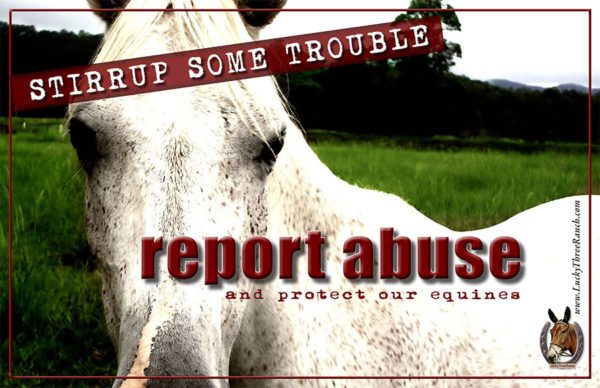 Educational Links: www.wildhoofbeats.com www.wildhorseeducation.org |

|
You’ve heard of April Fools’, but have you heard of April FOALS?
The following is from the American Wild Horse Campaign: Hey team, it’s April 1st and we all know what that means: April Fools' Day! But at American Wild Horse Conservation, we like to celebrate our own version: Happy April Foals Day! Foaling season runs from March through June, so April 1st is a perfect time to celebrate these babies and fight to protect them. Can you chip in now to help us celebrate this season's foals? Foals’ safety and their ability to live free is no joke. Here at AWHC, we work hard to reform the Bureau of Land Management (BLM) mass roundup and stockpile system through boots-on-the-ground conservation initiatives to ensure that wild foals have a chance to grow up wild. But we need your help to make sure these babies and their families don’t end up in captivity. We run two programs that help protect our wild foals, a Nevada-specific Foal Rescue Fund that helps fund critical vet care for babies in need on the Virginia Range and a roundup observation fund, that brings to light any mistreatment wild mustangs and their babies face during federal capture operations. And we need your help to fund our programs today → DONATE TO PROTECT THESE FOALS Let’s keep these babies wild, and give us a reason to celebrate April Foals Day year after year! Thank you for all you do, Team AWHC ...
Just $30 helps save a wild horse
The following is from the American Wild Horse Campaign: Did you know, that it only costs $30 to dart a single mare with the fertility control vaccine, PZP? This vaccine is humane, scientifically backed, and does not affect wild horses’ behaviors. Did you also know that this fertility control is critical to keeping horses wild? Your $30 donation will fuel our in-the-wild conservation initiatives that keep wild horses in the wild, where they belong. Here at American Wild Horse Conservation, we are proud to run the world’s largest humane fertility control program for wild horses on Nevada’s Virginia Range. Through this groundbreaking initiative, we are showing the public, the Bureau of Land Management (BLM), and our elected officials that there is a better way. This program is scientifically sound and a more cost-effective way to manage our wild horse and burro populations rather than subjecting them to brutal helicopter roundups year after year and funneling them into overburdened holding facilities. Our program is successful and even was the basis for a new peer-reviewed scientific paper, published in the journal Vaccines, that affirmed the feasibility of fertility control programs in large wild horse populations. Even better? Since the start of this program in 2019, there has not been one roundup and removal of the Virginia Range Mustangs. Your generosity fuels this program and ensures that we can continue and expand this critical work. So Meredith, we’re asking: Today, on March 30th, will you make a gift of $30 or more to fund our PZP program and help us continue our groundbreaking conservation work? $30 = ONE PZP VACCINE The success of our PZP programs has been so critical in our fight to protect wild horses because lawmakers and the public are starting to see there is a better way to manage our beloved wild horse and burro herds. And your support will help us continue to provide the cold, hard, scientific evidence that lends legitimacy to our calls for more humane management of our wild horses and burros. This fiscal year, 20,000 wild horses and burros are set to be rounded up through brutal and traumatic helicopter chases. Many of these animals will be funneled into holding facilities, adding far too many to the 64,000 already languishing in these pens. But we can fight back with your support! Will you please donate $30 today, on March 30th, to support the continued success ...
3 actions you can take RIGHT NOW to help wild horses and burros >>
The following is from the American Wild Horse Campaign: America’s wild herds are facing unprecedented challenges. Over 20,000 wild horses and burros are slated to be rounded up from their homes by the Bureau of Land Management (BLM) in Fiscal Year 2024. Many will join the over 60,000 who are already languishing in overburdened holding facilities. This inhumane system is at its breaking point. That’s why American Wild Horse Conservation (AWHC) is taking action to address the crisis affecting our wild herds and proactively ensure that wild horses and burros are treated humanely, both in holding and in the wild. But we cannot do it alone, Meredith! Here are three actions you can take NOW to help support the safety and freedom of our cherished wild horses and burros in 2024. 1) Sign on to Our Public Comments Calling for the Protection of the White Mountain Wild Horses Today is the last day to submit public comments regarding the BLM’s proposed plan to remove nearly 600 wild horses from the White Mountain Herd Management Area (HMA), a move that would drastically reduce the population to the low Appropriate Management Level (AML) of just 205 horses on nearly 400,000 acres of land. This unscientific population limit was set in 1997 and has remained unchanged ever since. TAKE ACTION 2) Tell Your Representative to Cosponsor the Wild Horse and Burro Protection Act of 2023-2024 (H.R. 3656) Right now, the BLM has paused its federal wild horse helicopter roundups for the foaling season, but as of July, they will be in full swing again. These roundups traumatize wild horses and burros. Deaths from broken necks and legs are routine, and sometimes horses are literally chased to death (called “capture myopathy”). H.R. 3656 would end this cruel practice once and for all. TAKE ACTION 3) Urge Representative to Cosponsor the Ejiao Act (H.R. 6021) Each year, millions of donkeys are brutally slaughtered for the production of ejiao, a medicinal gelatin that is made from boiling the skins of these animals. The donkey skin trade is now decimating global donkey populations as well as harming the impoverished global communities that rely on them for survival. That’s why U.S. House Representative Don Beyer (D-VA) has reintroduced the Ejiao Act (H.R. 6021), which would ban the knowing sale or transportation of ejiao made using donkey skin, or products containing ejiao made using donkey skin, in interstate or foreign commerce. TAKE ACTION Thanks ...
There’s still time! Speak up for Wyoming’s wild horses >>
The following is from the American Wild Horse Campaign: The horses who call Wyoming's White Mountain Herd Management Area (HMA) home need your help. SPEAK UP FOR WYOMING’S WILD HORSES The Bureau of Land Management (BLM) has proposed a plan to remove nearly 600 wild horses from the HMA, a move that would drastically reduce the population to the lowest Appropriate Management Level (AML) of just 205 horses on nearly 400,000 acres of land. This unscientific population limit was set in 1997 and has remained unchanged ever since. The current proposal has no plans to humanely manage the White Mountain wild horses with fertility control, setting the stage for yet another mass roundup in a few years. What’s worse, the BLM is basing the removal number on a 2022 census, conducted before the extremely harsh winter of 2023 which caused heavy mortality for wildlife, including wild horses, across Wyoming. Instead, the BLM is claiming that while the winter severely affected other wildlife species, it did not result in significant mortality in the White Mountain herd. That’s why AWHC is speaking out against this proposal through our public comments. Before the BLM undergoes any roundup, it must complete an updated scientific population estimate to have an accurate population count as well as undergo a full Environmental Assessment to ensure a thriving natural ecological balance. Further, it must consider the use of humane, reversible fertility control in any further management planning. If you haven’t already, please sign on to our public comments and speak up for Wyoming’s wild horses! The public comment period is open until March 22, so there’s still time to use your voice on behalf of these iconic animals. SPEAK UP FOR WYOMING’S WILD HORSES Thank you ...
Delving into the rich history of America’s iconic wild horse herds
The following is from the American Wild Horse Campaign: Wild horses are deeply interwoven into the fabric of the American West. Yet, many people are unaware of the long history these iconic animals have in the United States. Today, we’d like to tell you about a little wild horse history, but first, please consider chipping in to help power our work to protect our wild herds! >> POWER OUR WORK Origins Photo by Kimerlee Curyl America’s wild horses are considered a native re-introduced species. A native reintroduced species is a species that at some point became locally extinct in its indigenous lands, but eventually returned, either on its own or by being reintroduced back to the land by human beings. This is what happened to America’s wild horses. Wild horses began to evolve and grow on the North American continent millions of years ago. In fact, the forerunner to the modern horse was traced to the Tennessee Valley. During glacial periods, when the sea level would drop, wild horses would move back and forth across the Bering Land Bridge into Siberia. About 12,000 years ago, the wild horses of North America went locally extinct, but they were not globally extinct. On the contrary, wild horses thrived in Asia and were eventually domesticated approximately 6,000 years ago. The domestication of horses spread throughout Asia and Europe. Finally, when Europeans came to North America in the 1500s, they brought their horses with them, re-introducing a native species back to its place of origin! America’s Disappearing Wild Horses Photo by Kimerlee Curyl In the 19th century, the population of wild horses in America was estimated to have reached more than two million. But by the time the wild horse received federal protection in 1971, it was officially estimated that only about 17,000 of them roamed America's western lands. More than 1 million had been conscripted for World War I combat; the rest had been hunted for slaughter, and even for the sport of it. These innocent animals were chased by helicopters and sprayed with buckshot; they were run down by motorized vehicles and, deathly exhausted, weighted with tires so they could be easily picked up by rendering trucks. They were run off cliffs, gunned down at full gallop, shot in corralled bloodbaths, and buried in mass graves. This horror brought America’s wild horses to the brink of extinction until one woman decided to take action… The Beginning of Wild Horse Conservation Velma ...
